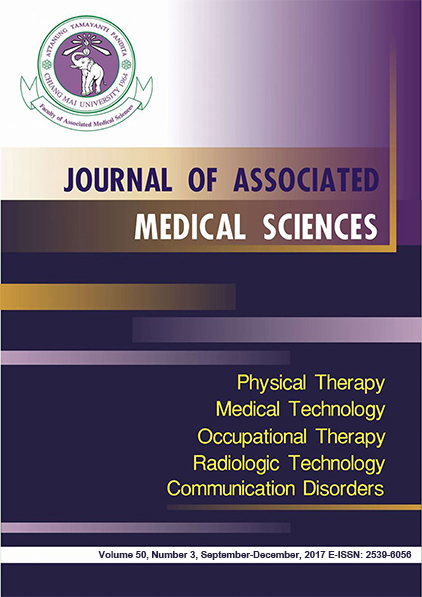Comparisons of respiratory muscle strength and chest expansions between obese class I and normal weight females
Main Article Content
Abstract
Background: Obesity is a medical condition which increases body fat and a negative effect on respiratory system.
Objectives: To compare the respiratory muscle strength and chest wall expansions between obese class I and normal weight females.
Materials and methods: Ninety female participants aged 18-30 years old were equally divided into normal weight (BMI 19.28±0.57 kg/m2) and obese class I (BMI 26.32±0.64 kg/m2) groups. Maximal inspiratory pressure (MIP) and maximal expiratory pressure (MEP) were measured in both groups by respiratory muscle meter. Chest expansions at the upper, middle and lower part of thorax were assessed using a tape measurement.
Results: MIP and MEP were significantly different between groups (p<0.05). Additionally, respiratory muscle strength of obese class I group was higher than those in the normal weight group. The upper, middle, and lower chest expansions in obese class I group were higher than those in normal weight group (p<0.05).
Conclusion: Respiratory muscle strength and chest wall expansions in obese class I female participants were higher than those in normal weight females.
Article Details
Personal views expressed by the contributors in their articles are not necessarily those of the Journal of Associated Medical Sciences, Faculty of Associated Medical Sciences, Chiang Mai University.
References
2. World Health Organization (WHO). WHO Global InfoBase: data on overweight and obesity, mean BMI, healthy diets and physical inactivity. 2011.
3. Kantachuvessiri A. Obesity in Thailand. J Med Assoc Thai 2005; 88(4): 554-62.
4. Aekplakorn W, Mo-Suwan L. Prevalence of obesity in Thailand. Obes Rev 2009; 10(6): 589-92. doi: 10.1111/j.1467-789X.2009.00626.x.
5. Brown A, Siahpush M. Risk factors for overweight and obesity: results from the 2001 national health survey. Public Health 2007; 121(8): 603-13. Epub 2007 Jun 13.
6. Mongkol S. The effect of obesity on respiratory and cardiovascular system. Bull Chiang Mai Assoc Med Sci 2012; 45(3): 10-6 (in Thai).
7. Mongkol S, Chanthaphun S. A comparison of pulmonary function and respiratory muscle strength in overweight, class I and class II obesity. J Med Tech Phy Ther 2014; 26(1): 48-55. (in Thai).
8. Rasslan Z, Junior RS, Stirbulov R. Evaluation of pulmonary function in class I and II obesity. J Bras Pneumol 2004; 30(6): 508-14.
9. American Thoracic Society/European Respiratory Society. ATS/ERS statement on respiratory muscle testing. Am J Respir Crit Care Med 2002; 166: 518–624. doi: http://dx.doi.org/10.1164/rccm.166.4.518
10. Inal-Ince D, Savci S, Arikan H, Saglam M, Vardar-Yagli N, Bosnak-Guclu M, et.al. Effects of scoliosis on respiratory muscle strength in patients with neuromuscular disorders. Spine J 2009; 9(12): 981-6. doi: 10.1016/j.spinee.2009.08.451.
11. Mongkol S, Teethaisong Y, Korngkit J, Inaugson N. The comparisons of respiratory muscle strength and six-minute walk distance between female obesity class I and normal-weight. J Med Tech Phy Ther 2013; 25(3): 289-96 (in Thai).
12. Bockenhauer SE, Chen H, Julliard KN, Weedon J. Measuring thoracic excursion: reliability of the cloth tape measure technique. J Am Osteopath Assoc 2007; 107: 191-6.
13. Black L, Hyatt R. Maximal respiratory pressures: normal values and relationship to age and sex. Am Rev Respir Dis 1996; 99: 696-702.
14. Parameswaran K, Todd DC, Soth M. Altered respiratory physiology in obesity. Can Respir J 2006; 13(4): 203-10.
15. Khrisanapant W. Obesity and respiratory muscle strength in Thai women. JPBS. 2011; 24: 78-82.
16. Luce JM. Respiratory muscle function in health and disease. Chest 1982; 81(1): 82-90.
17. Costa D, Barbalho MC, Miguel GP, Forti EM, Azevedo JL. The impact of obesity on pulmonary function in adult women. Clinics (Sao Paulo) 2008; 63(6): 719-24.
18. Weiner P, Waizman J, Weiner M, Rabner M, Magadle R, Zamir D. Influence of excessive weight loss after gastroplasty for morbid obesity on respiratory muscle performance. Thorax 1998; 53: 39-42.
19. Ozgocmen S, Cimen OB, Ardicoglu O. Relationship between chest expansion and respiratory muscle strength in patients with primary fibromyalgia. Clin Rheumatol 2002; 21(1): 19-22.


